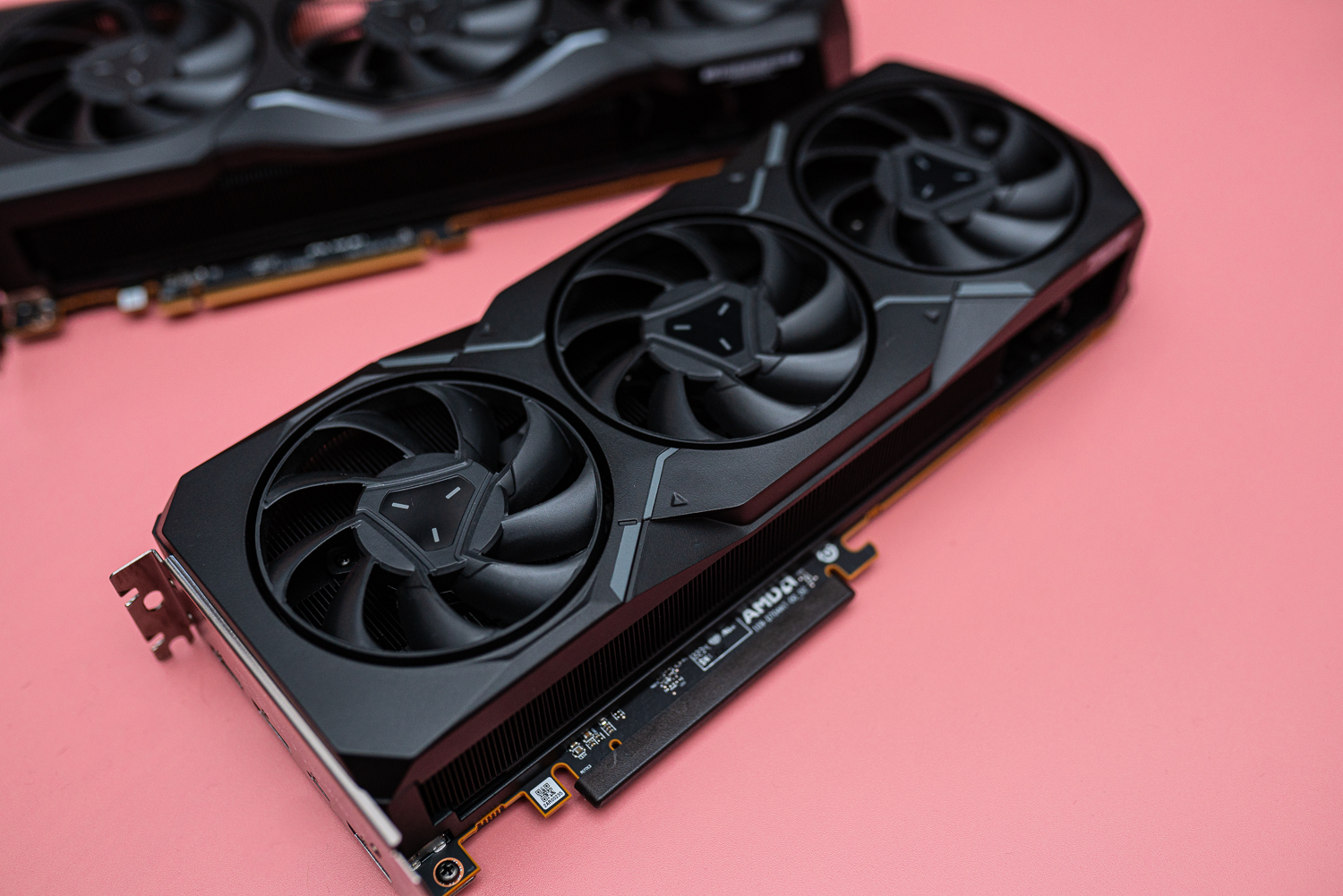The long-awaited RX 7000 series has finally arrived, or more specifically, AMD’s two top-end GPU flagships have. The 7900 XT and the 7900 XTX are set to go head-to-head with the Nvidia RTX 4080, although they may not keep up with the RTX 4090.
Given how different the 4080 and 4090 are from each other, you might wonder if the same thing is going on with the 7900 XT and the 7900 XTX. Here’s everything we know so far.
Pricing and availability
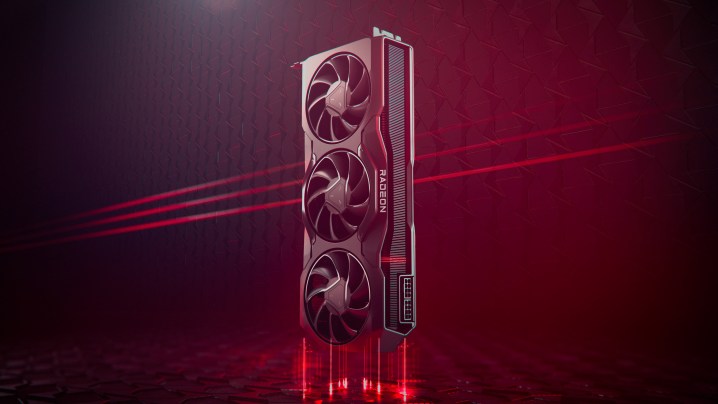
Announced for the first time on November 3, 2022, the 7900 XT and 7900 XTX are up for grabs starting December 13, priced at $900 and $1,000, respectively. The pricing structure here is similar to the RX 6000 series, which had the $999 RX 6900 XT, then added a $900 GPU.
This could help bridge the gap between the higher-end RX 7000 GPUs with the top-end models; by contrast, the RX 6800 XT launched for $649, well below the 6900 XT’s price tag, with no GPU in between the two models.
Specs: RX 7900 XT vs. RX 7900 XTX
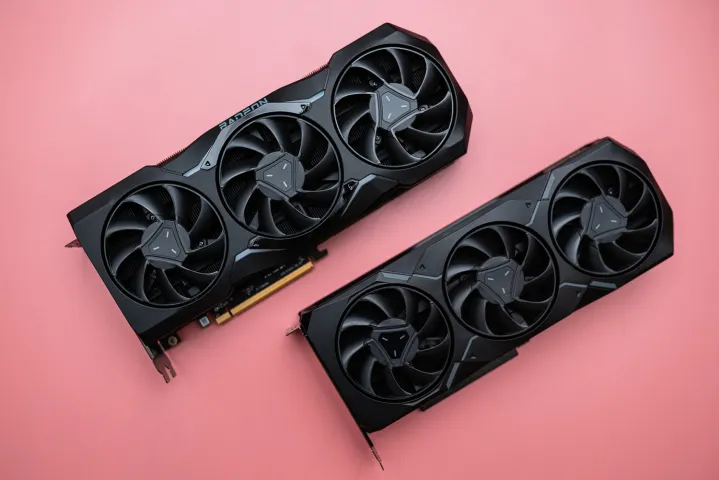
Here’s a quick look at how these two models differ on the spec sheet.
| AMD Radeon RX 7900 XTX | AMD Radeon RX 7900 XT | |
| GPU | Navi 31 | Navi 31 |
| Process node | TSMC 5nm (GCD), TSMC 6nm (MCD) | TSMC 5nm (GCD), TSMC 6nm (MCD) |
| Cores | 6,144 | 5,376 |
| Compute units | 96 | 84 |
| Ray tracing accelerators | 96 | 84 |
| AI accelerators | 192 | 168 |
| Game clock | 2,300MHz (Game clock) / 2,500MHz (Boost clock) | 2,000MHz |
| Memory size | 24GB GDDR6 | 20GB GDDR6 |
| Memory bus width | 384-bit | 320-bit |
| TBP | 355W | 315W |
Essentially, the 7900 XTX has the full Navi 31 GPU with all the bells and whistles, while the 7900 XT is slightly cut down. The XT model has 84 of the 96 Compute Units (or CUs) that Navi 31 has to offer, a clock speed of 2GHz as opposed to the 2.3GHz on the XTX, and 20GB of memory instead of 24GB GDDR6.
The Total Board Power (TBP) for the 7900 XT is also a little lower, of course, as is the clock speed. Overall, both GPUs are quite similar — the only real difference lies in the performance.
RDNA 3 Architecture
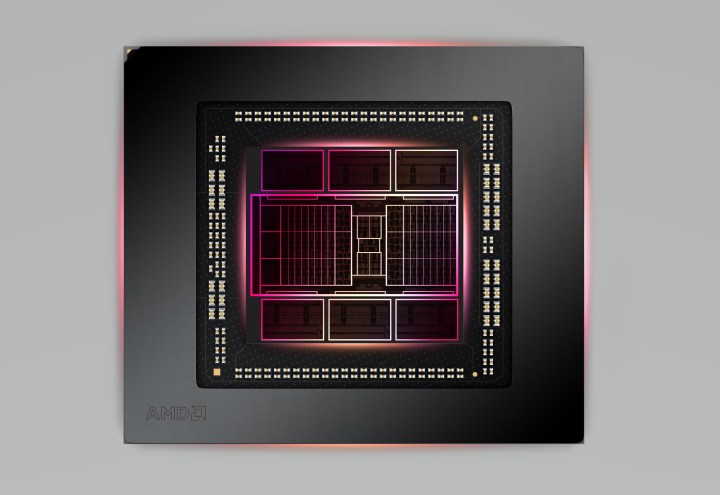
The 7900 XT and 7900 XTX are both powered by the new RDNA 3 architecture, which is radically different from RDNA 2, the architecture inside of RX 6000-series GPUs. The two GPUs share the same architecture, but it’s worth exploring when considering AMD’s latest and greatest.
Most importantly, chiplets, the technology that propelled Ryzen into first place in 2019, have finally come to GPUs. That’s big news, but the chiplet design for RX 7000 is in many ways very different from what we’ve seen with Ryzen and other AMD CPUs. Instead of having multiple dies for cores and one extra die for I/O and other functions, RX 7000 GPUs have one die with all the cores and several dies that each have one GDDR6 memory controller and 16MB of Infinity Cache. The chip with all the GPU cores is now called the Graphics Compute Die (GCD) and the chips with memory controllers and cache are Memory Cache Dies (MCD).
This means an RX 7000 GPU (specifically the 7900 XTX) can have up to 96MB of Infinity Cache and a bus width of 384-bit, which together allow the 7900 XTX to hit a peak bandwidth of 5.3 TB/s. Meanwhile, the 7900 XT appears to have one less MCD and thus has just 80MB of cache and a 320-bit bus, as well as 4GB less VRAM. Lower-end RX 7000 GPUs will likely use a different GCD and even fewer MCDs, but we’ll have to wait until those are announced next year for all the details.
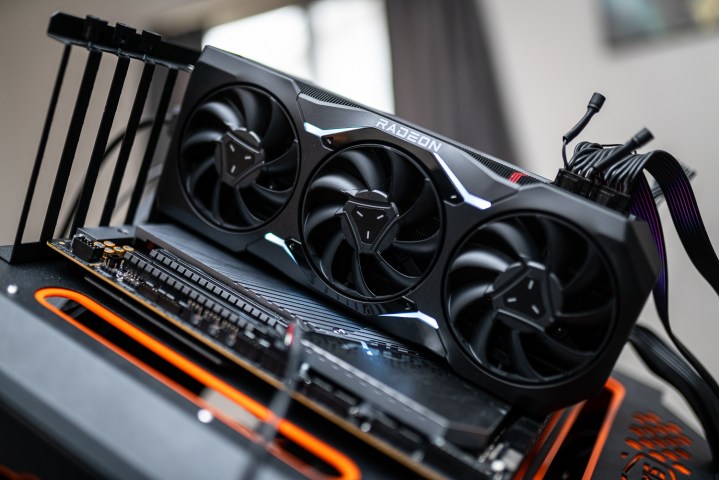
RDNA 3 also comes with a new node. Last-generation RX 6000 GPUs were fabbed on TSMC’s 7nm node; now, RX 7000 GCDs are fabbed on 5nm, which has up to 1.8 times the transistor density of 7nm, as well as a 15% clock speed boost for the same power consumption or 30% less power at the same clock speed. Combined with architectural improvements, 5nm reportedly allows RDNA 3 to be 54% more efficient than RDNA 2.
Meanwhile, RX 7000’s MCDs are fabbed on TSMC’s 6nm node, which is basically 7nm, but with a focus on efficiency, low power, and low cost. Cache and I/O devices like memory controllers are increasingly more difficult to shrink with every new generation, which is why AMD is sticking with 6nm for these MCDs; 5nm is just too expensive while providing little improvement for this kind of stuff.
Performance
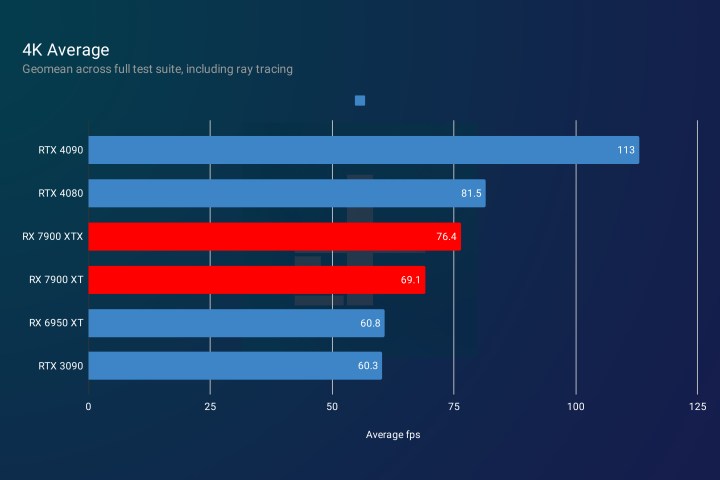
Based on our own testing of the AMD Radeon RX 7900 XTX and the RX 7900 XT, it’s safe to say that these are two solid GPUs. AMD manages to keep up with — and in some cases even outpace — the Nvidia RTX 4080. However, performing on the level of the beastly RTX 4090 is nothing but a pipe dream that AMD never even planned to entertain. Both the 7900 XTX and the 7900 XT are being presented as rivals of the RTX 4080, and in that, they mostly succeed. Let’s take a look at some performance metrics.
Testing the cards in 4K gaming scenarios reveals that they’re close to the 4080. The RX 7900 XTX is around 6% slower, while the gap for the 7900 XT is considerably larger at around 15%. Compared to the last generation, there are some performance gains, but they’re not as drastic as was the case for the RTX 4090. The flagship RX 7900 XTX beats the previous-gen RX 6950 XT by 26%, while the RX 7900 XT trails behind the XTX, but still beats the 6950 by 14%. Both the cards beat the RTX 3090, but the lead is not as significant as one might have hoped.
On the other hand, if all you care about is the ability to game at 4K, you’ll definitely find that in both these cards — and cheaper than Nvidia, too. In terms of frames per second (fps), the 7900 XTX scored an impressive 62.4 fps in Cyberpunk 2077. That’s marginally higher than the RTX 4080 (58.9 fps) and the 7900 XT (57.6 fps). Overall, across all of the titles we’ve tested at 4K, the RX 7900 XTX maintained around 76.4 fps on average, followed by the RX 7900 XT with 69.1 fps.
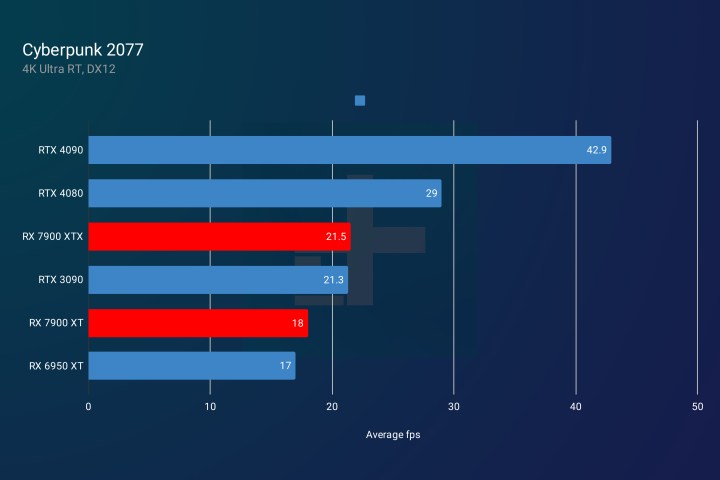
Unfortunately, AMD doesn’t shine when you look at ray tracing. There are some improvements, sure, but Nvidia is still the undisputed king of ray tracing, and for now, AMD doesn’t even come close to challenging Team Green.
Playing Cyberpunk 2077 at 4K with ray tracing enabled is only really possible on the RTX 4090 (and even then, it’s still not ideal), but still, the RTX 4080 manages to maintain a big lead over the two Radeons. In fact, the flagship 7900 XTX just barely beats the last-gen RTX 3090, scoring a mere 21.5 fps. The 7900 XT fares even worse with 18 fps.
Closer than Nvidia

After seeing the massive difference between the RTX 4090 and the RTX 4080 (especially that canceled 12GB model), it’s a relief to see RX 7000 isn’t repeating that situation. As far as GPU launches go, the 7900 XT and 7900 XTX are a bit conventional, with the XTX model representing the best of the best AMD has to offer. while the XT is a bit more cut down for a lower price.
So, based on our own testing, which GPU should you buy? At the moment, the 7900 XTX is certainly the better deal. For $100 more, you get much better value across the board. It can offer top-notch 4K gaming performance, and if you don’t care too much about ray tracing and upscaling, you won’t regret picking AMD over Nvidia this time around.
Unfortunately, the RX 7900 XT is just not worth it. In almost any scenario, you’d be better off spending that extra $100 and getting the improvements that the RX 7900 XTX brings.
Editors’ Recommendations
